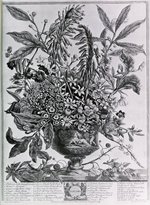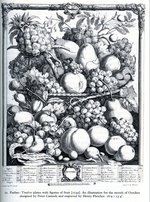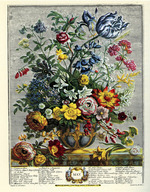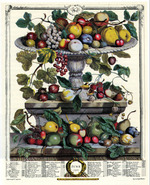According to John Harvey, who published important studies of the development of British plant catalogues before the 1840s, printed catalogues were rare before the mid-eighteenth century.1 Before that time, merchants conducted most business locally and many people saved or exchanged their own seeds and plants. Seeds and plants were also often sold as a side business by estate gardeners or by merchants who also sold other wares. Documentary evidence shows the existence of nurserymen and seedsmen around London from the early sixteenth century; however, the oldest surviving copies of English seed and nursery trade catalogues date from the second half of the seventeenth century2. Robert Furber of the Kensington Nursery published the oldest surviving printed catalogue in pamphlet form in 1727.3 Nurserymen, seedsmen and botanists from the late sixteenth to eighteenth centuries also published gardening books, pamphlets, and gardeners’ calendars that listed seeds or plants for sale.4 Publishing instructional literature saved the seedsman or nurseryman the trouble of writing directions for individual customers.5 It also provided good publicity, and helped protect his reputation, since customers might blame him if they were unsuccessful with the plants he sold.6
As canal networks expanded and more landowners planted trees and landscaped pleasure grounds, more seed and nursery firms were established both inside and outside London. The oldest surviving fully priced printed catalogue came from York in 1775.7 Harvey speculated that many of the first priced lists came from nurseries in North England and Scotland, because their clients were less wealthy and lived in a wider geographic range than London’s nursery customers did.8 Printed catalogues became more common over the course of the eighteenth century as competition between nurseries increased.9
The oldest illustrated English flower catalogue is Twelve Months of Flowers. It was a series of engraved plates, sold by subscription in 1730 by Robert Furber to his royal and aristocratic clients. Instead of presenting plant species individually, the pictures display flowers in lavish bouquets in the style of Flemish flower paintings; indeed, Henry Fletcher engraved the plates after paintings by the artist Pieter Casteels, from Antwerp. Customers were offered the option of buying uncolored or painted sets.10 Furber issued the equally extravagant Twelve Months of Fruit in 1732. Although few catalogues survive from the seventeenth and eighteenth centuries, the nursery trade grew during this period and there were approximately 200 seed and nursery firms by 1800 in England and Wales.11 Most catalogues before 1800 were unillustrated lists in broadsheet or booklet form; however, some provided additional information such as botanical nomenclature12 and cultural instructions13, and there were several firms that issued catalogues containing a small number of illustrations.14
[Images used on this page were originally published in Twelve Months of Flowers (1730) or Twelve Months of Fruits (1732). OSU does not hold original copies of these materials in its collections.]
Notes
- John H. Harvey, Early Gardening Catalogues (London and Chichester, Phillimore, 1972) 14
- Harvey, Early Gardening Catalogues 4-8
- Blanche Henrey, A History and Bibliography of British Botanical and Horticultural Books up to 1800, vol.2 (London, New York and Toronto, 1975) 343; Harvey, Early Gardening Catalogues 14
- John H. Harvey, Early Nurserymen (London, Phillimore, 1974) 145; Malcolm Thick, Garden Seeds in England before the late eighteenth century-II”, Agricultural History Review, 38, #2, 1990: 107. Thick mentions that the first English vegetable gardening book by Richard Gardiner in 1599 also contained a price list of vegetable seeds he sold.
- Henrey 328
- Thick 112
- Harvey, Early Gardening Catalogues 36
- Harvey, Early Gardening Catalogues 35-36
- Henrey 408
- Harvey, Early Gardening Catalogues 14; Henrey 343-4.
- Harvey, Early Nurserymen 7
- Harvey, Early Gardening Catalogues 40 says catalogues using Latin binomial names and English names appeared in the 1770s.
- Harvey, Early Gardening Catalogues, 66 says book-form catalogues containing cultural instructions and gardeners’ calendars date from the mid 18th century.
- Brent Elliot, Nursery Catalogues. Royal Horticultural Society. Available at http://www.rhs.org.uk/About-Us/RHS-Lindley-Library/Projects/Nursery-catalogues/Dr-Brent-Elliott





